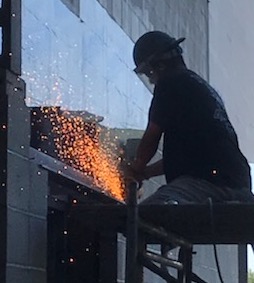Years ago, I was standing on a street corner in Saskatoon waiting for the light to change early one morning. I saw a young Indigenous man racing towards me on a bicycle likely on his way to the construction site behind me. He was dressed in PPE and obviously wanted to get there on time. He timed the light perfectly and flew past me. As he went by, I could see that under his hard hat, his hair was dyed Rider green. I was so happy to see a young Indigenous construction worker supporting my favourite football team. I also wondered if he was perhaps helped by the Construction Careers Program we had started several years ago. I thought, “Wouldn’t that be cool,” and I continued on to my meeting.
Years ago, Bosgoed Projects were the Project Coordinators of the Saskatchewan Indian Federated College (SIFC), now the First Nations University of Canada (FNUC). It was designed by world-renowned indigenous architect Douglas Cardinal and a unique design and project.
It was the FNUC’s desire that First Nations people participate in all aspects of construction. The project was already unique in that the Architect and Project Coordinator were Indigenous-owned, and the iconic design continues to inspire indigenous people everywhere.
The project delivery included the selection of a general contractor and dozens of subtrade contractors based on a competitive bidding process. With no Indigenous-owned general contractors available, we realized that the traditional process of bidding would produce very few Indigenous workers if we did not provide bidders with more local capacity. We felt that contractors were not going to put the effort into finding FN workers. Bidding periods are typically three weeks and that time is governed by rigid procedures in order to submit a complete and comprehensive bid by the deadline.
We considered visiting all of the First Nations in Saskatchewan in order to canvas for potential workers, but only a few had databases on location for of their urban Band members. The project wasn’t fully funded yet, so we decided to make good use of the time to address this issue.
A “bridge” was needed between the contractors and the Indigenous workers. We decided that we needed one stop shopping; a database that workers could post their resumes and contractors could post their positions. We viewed this bridge as a low-cost operation that could exist in a First Nations organization. As well, we recognized the support of the construction industry was important. We visited the File Hills Qu’Appelle Tribal Council urban office and the Construction Association, explained the concept, and gained the support of both to participate.
Each organization assigned a person to the advisory board to support their activity for the next several years. Over the next two years, the group built a database, an industry advisory group and hands-on construction courses. An small organization was created in the Tribal Council which included indigenous advisors, resume writers, and instructors
When the database was ready, the FNUC project still wasn’t fully funded, so we offered the services to local contractors. They jumped at the opportunity and the program thrived! Some of the contractors also joined the steering committee.
It turned out the SIFC project was delayed by two years. By the time construction started in 2001, there were over 1,200 names on the database. We used the database on the project and PCL completed construction with almost sixty percent Indigenous workers. Since then, the database in Saskatchewan has grown to over 15,000 work-ready Indigenous workers who have gained employment. So, what had started as a project-specific initiative became a regional provider of Indigenous workers.
Presently, the Saskatchewan Indian Institute of Technology (SIIT) delivers the program through seven locations across Saskatchewan. We brought the program to a number of colleges in Alberta, and Norquest College immediately initiated the program. To date, over 3,000 Indigenous people in Alberta have been served. The “bridge” is in place in Alberta and ready for use.
If you are a contractor looking for Indigenous workers for an off-reserve project, please contact the Alberta Indigenous Construction Careers Program at Norquest College.
Stay safe, everyone!
~ Gary and the team at Bosgoed Projects




